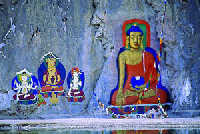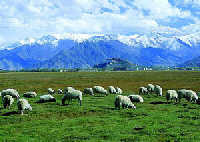| |
Lhasa:World's Highest City
( 2005-10-14 )
 Lhasa, the capital of China's Tibet Autonomous Region, has a history of more than 1,300 years. It is the political, economic, cultural and transport center of the region. Located at the bottom of a small basin surrounded by mountains, Lhasa has an elevation of 3,658 meters, making it perhaps the highest city in the world. Lhasa, the capital of China's Tibet Autonomous Region, has a history of more than 1,300 years. It is the political, economic, cultural and transport center of the region. Located at the bottom of a small basin surrounded by mountains, Lhasa has an elevation of 3,658 meters, making it perhaps the highest city in the world.
Today, Lhasa exercises jurisdiction over seven counties (Damshung, Tolun Dechen, Chushur, Medro Gongkar, Taktse, Nyemo and Lhundup) and one district (City Proper). It covers an area of close to 30,000 square kilometers. It has adowntown of 544 square kilometers and a population of 500,000; 140,000 of its people live in the downtown area. Lhasa is home to the Tibetan, Han, and Hui peoples, as well as many other ethnic groups, but the Tibetan ethnic group makes up 87 percent of the population.
Blessed with flat land and mild weather, Lhasa is free of frigid winters and unbearably hot summers, having an annual average daily temperature of 8℃. It enjoys 3,000 hours of sunlight annually, much more than all other cities in the area, giving it the title of "sunlit city."
Lhasa enjoys an annual precipitation of 500 mm. It rains mainly in July, August and September. The rainy seasons in the summer and fall are the best seasons of the year, when it rains mostly at night and is sunny in the day.
Lhasa has beautiful scenery. The Lhasa River, known as the "merry blue waves," runs through the snow-covered peaks and gullies of the Nyainqentanglha Mountains, extending 315 kilometers. The river empties into the Yarlung Zangbo River at Quxu, forming a scenic wonder that features blue and white water waves.
The ancient city of Lhasa stands by the Lhasa River. Inside the city towers the Potala Palace. The city features a combination of traditional and modern things, including prayer wheels and computers.
|
|

